For many retirees, the question of whether to convert a Traditional IRA to a Roth IRA comes up at some point. On paper, the concept is simple: you pay taxes now on the amount you convert, and from then on, the Roth grows tax-free. But in practice, deciding if — and when — a Roth conversion makes sense requires careful thought.
Let’s walk through the details.
Why Consider a Roth IRA Conversion?
A Roth IRA offers two powerful benefits:
- Tax-free growth and withdrawals in retirement (if the account is held for at least five years and you’re over age 59½).
- No Required Minimum Distributions (RMDs) during your lifetime, unlike Traditional IRAs.
This can provide more flexibility later in retirement and potentially lower taxes for your heirs.
The Trade-Off: Taxes Today vs. Taxes Later
When you convert, you’re moving money from a pre-tax bucket (Traditional IRA) to an after-tax bucket (Roth IRA). That means:
- The amount converted is treated as ordinary income in the year of conversion.
- You’ll owe federal (and possibly state) income tax on the converted amount.
Example: If you convert $50,000 in 2025 and stay within the 12% tax bracket, you may owe about $6,000 in taxes. But if you convert too much and spill into the 22% bracket, the extra income above the 12% ceiling could cost almost double in taxes on each additional dollar.
Tax Brackets and Conversion Planning
For 2025 (Married Filing Jointly):
- The 12% bracket goes up to about $94,300 of taxable income.
- Above that, you jump to the 22% bracket, a steep increase in tax liability.
Planning Tip: Many retirees aim to “fill up” the 12% bracket each year with Roth conversions while avoiding spilling into the higher 22% bracket. This can keep the tax bill more manageable and spread conversions over multiple years.
When a Roth Conversion Might Make Sense
- Low-Income Years Before RMDs
If you retire at 62 but delay Social Security until 70, you may have several years of relatively low taxable income. Converting up to the top of the 12% bracket in those years can be especially efficient. - Concern About Rising Taxes
With tax brackets scheduled to revert to higher levels in 2026 unless laws change, many retirees see a limited window to convert at today’s lower rates. - Legacy Planning
Heirs who inherit Roth IRAs must still withdraw funds under the 10-year rule, but those withdrawals are tax-free. This can be especially valuable if your children are in their peak earning years.
When a Roth Conversion May Not Be the Best Fit
- Paying Taxes from IRA Funds: If you use IRA money to cover the tax bill, you lose investment potential inside the Roth. Worse, if you’re under 59½, paying the tax from IRA funds could also trigger penalties.
- Impact on Medicare Premiums: Medicare IRMAA surcharges apply if your modified adjusted gross income exceeds certain thresholds. For 2025, the first tier begins at $206,000 for joint filers and $103,000 for single filers. Even modest conversions likely won’t trigger this, but larger ones could.
- Other Tax Effects: Conversions can affect taxation of Social Security benefits, eligibility for certain credits, and state tax obligations. In Massachusetts, for instance, Roth conversions are taxable at the state level.
- Near-Term Withdrawals: If you’ll need the funds within five years, remember the Roth 5-year rule. Withdrawing converted amounts too soon can trigger penalties.
A Common Mistake to Avoid
Converting “all at once” without considering tax brackets can backfire. It’s often more efficient to spread conversions over several years, staying within the 12% bracket each year rather than leaping into 22% or higher.
Scenario Spotlight: A couple retiring at 63 with $60,000 in annual living expenses, $20,000 covered by taxable accounts, and $40,000 needed from IRA withdrawals might convert an extra $30,000–$40,000 each year to Roth. This keeps them in the 12% bracket, avoids the sharp tax jump, and slowly builds a meaningful Roth balance before RMDs begin.
Key Takeaways
- Roth conversions can reduce long-term taxes but increase near-term taxes.
- Staying within the 12% bracket is often the sweet spot for many retirees.
- The best windows often fall between retirement and RMD age (currently 73).
- Pay conversion taxes from outside cash if possible.
- Be mindful of Medicare IRMAA thresholds, tax brackets, and Social Security taxation.
Roth IRA conversions can be a smart tool, but they aren’t a one-size-fits-all solution. For some retirees, the benefits are significant. For others, the tax cost outweighs the long-term gain. Running the numbers year by year with a financial professional can help clarify what’s right for your situation.
This material is provided for informational purposes only and is not intended as financial advice. Evergreen Wealth Management does not guarantee investment outcomes. Please consult a qualified professional before making decisions about your personal financial situation.
